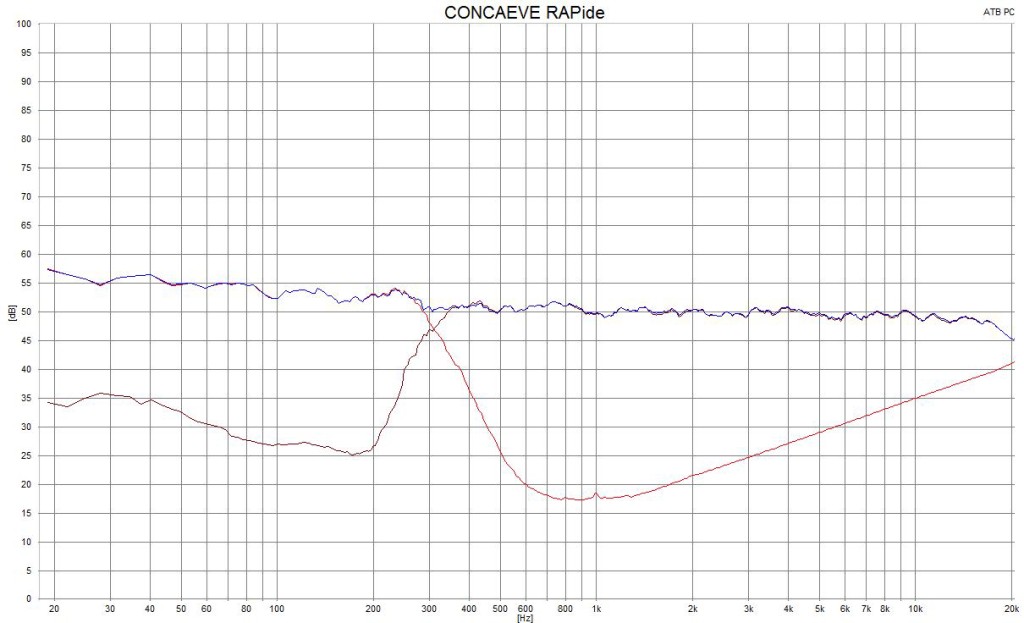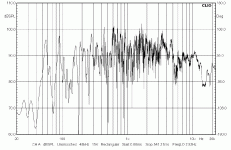For 'seems very linear', read 'heavily smoothed FR graph.'  If something looks too good to be true, it is. Which isn't to suggest it's a bad driver, just that it's extremely unlikely to be any 'better' (whatever that means) in this particular respect than any other.
If something looks too good to be true, it is. Which isn't to suggest it's a bad driver, just that it's extremely unlikely to be any 'better' (whatever that means) in this particular respect than any other.
Anyway, yes, it will work in a horn or waveguide. That's no big deal; pretty much any driver will work in a horn or waveguide, assuming it's designed properly.
Anyway, yes, it will work in a horn or waveguide. That's no big deal; pretty much any driver will work in a horn or waveguide, assuming it's designed properly.
Last edited:
Read my MPL thread. I have the Scan Speak in a simple open baffle with subwoofer and it works very well.
Thats just great! With measurements and everything
When you change the voicecoil, everything changes. The higher impedance voicecoil may see a comparatively lower inductance and that may be the difference in extention.
A 4 Ohm voicecoil has also higher mass usually but may fill the gap better. I have so far only experience with the 4 Ohm version and treble extension is just fine. More treble could not hurt and you can adjust the balance by angling the speakers more in, so that they cross before your ears. That also helps to smouth the whole trend. I use no crossover and tonal balnce is just right. So far the best commercial little wideband i heard and measured.
A 4 Ohm voicecoil has also higher mass usually but may fill the gap better. I have so far only experience with the 4 Ohm version and treble extension is just fine. More treble could not hurt and you can adjust the balance by angling the speakers more in, so that they cross before your ears. That also helps to smouth the whole trend. I use no crossover and tonal balnce is just right. So far the best commercial little wideband i heard and measured.
Most discussion here:
Vance Dickason tested new SS 10F - Techtalk at Parts-Express.com
Try post #9, on the evaluation of this driver.
Vance Dickason tested new SS 10F - Techtalk at Parts-Express.com
Try post #9, on the evaluation of this driver.
Doesnt look that smoothed too me, with all those wrinkles. If there would be any serious peaks, it would show, even on a more smoothed graph.
I wouldn't bet on it. This is what raw data looks like:
Most manufacturers are economical with the truth with their published FR plots. Smoothing can be anything from minimal to 1/2 octave or more (and they very rarely tell you how much). Another slightly more subtle favourite, is to expand the dynamic range on the chart to a huge value. Then they can play around with the resolution of the data sheet & size of the image... lots of lovely ways there. Some are better than others, but ROT is don't take them at face value; about all they're good for is assessing general trends.
Attachments
Most discussion here:
Vance Dickason tested new SS 10F - Techtalk at Parts-Express.com
Try post #9, on the evaluation of this driver.
Thanks for the measurements. I would love to compare them to some of the Fostex drivers. Even tho the SS is way more linear...

I wouldn't bet on it. This is what raw data looks like:
Most manufacturers are economical with the truth with their published FR plots. Smoothing can be anything from minimal to 1/2 octave or more (and they very rarely tell you how much). Another slightly more subtle favourite, is to expand the dynamic range on the chart to a huge value. Then they can play around with the resolution of the data sheet & size of the image... lots of lovely ways there. Some are better than others, but ROT is don't take them at face value; about all they're good for is assessing general trends.
I will take a smoothed graph over that graph anyday. One isnt able to hear all those tiny peaks and dips anyway. Tonal balance is what matters, at least to me
I will take a smoothed graph over that graph anyday. One isnt able to hear all those tiny peaks and dips anyway. Tonal balance is what matters, at least to me
Who said anything about 'tiny?' Very little smoothing will cause those to vanish, but larger abberations also get wiped out as well. That's why they do it. And is the point I'm making, i.e. that factory plots are almost always fairly heavily smoothed, which may disguising some less-then-pleasant characteristics, and therefore don't take them at face value.
Last edited:
Scottmoose, the grapshs provided by Scan-Speak, SEAS, Peerless and Vifa are pretty "honest", when compared to the Tang Band ones, which are usually too optimistic and they often exaggerates the Fs to a much lower value (W3-871 actual fs was about 140Hz, and TB claimed it was about 110Hz)
No surprise there; TB can pull off some nice units (and some rotten ones), but their published data is known to be questionable, albeit itself usually superior to a few others (Audio Nirvana -who mentioned them ? 

 )
)
Nope, while I'd agree these guys are 'better' in this regard (everything's relative after all) than some, they're still not good enough IMO. Accuracy of manufacturer data, and stating what their production QC tolerances are, has become a bit of a hobby horse of mine of late.
Nope, while I'd agree these guys are 'better' in this regard (everything's relative after all) than some, they're still not good enough IMO. Accuracy of manufacturer data, and stating what their production QC tolerances are, has become a bit of a hobby horse of mine of late.
Last edited:
When you change the voicecoil, everything changes. The higher impedance voicecoil may see a comparatively lower inductance and that may be the difference in extention.
A 4 Ohm voicecoil has also higher mass usually but may fill the gap better. I have so far only experience with the 4 Ohm version and treble extension is just fine. More treble could not hurt and you can adjust the balance by angling the speakers more in, so that they cross before your ears. That also helps to smouth the whole trend. I use no crossover and tonal balnce is just right. So far the best commercial little wideband i heard and measured.
I think I'll go for the 8 ohm version then
Last edited:
Done outdoors and closer to the speaker, say 50cm a lot of ripples disappear. What you see is reflexions that spoil the response. You could measure much closer, say 2 to 10cm and see the real behaviour of the membrane. That does not tell you how it sounds at the listening space though because acoustic impedance is not shown in those nearfield measurements.
Done outdoors and closer to the speaker, say 50cm a lot of ripples disappear. What you see is reflexions that spoil the response. You could measure much closer, say 2 to 10cm and see the real behaviour of the membrane. That does not tell you how it sounds at the listening space though because acoustic impedance is not shown in those nearfield measurements.
Is it the same case with drivers measured in an anechoic chamber?
If they are totally anechoic, yes. Usualy they have a low frequency limit, somewhere between 50 and 200Hz dependent on size and construction so i prefer oudoors on ca. 3 to 5m high stands if i want the full measure. Freefield and nearfield can be combined. Don Keele made a paper about that and that is what i usually do. Praxis, the software i am using has a script that allows that. How you tune your speaker in the bass has to do with roomplacement and preferences. When i build a conventional speaker i usually use an oversized reflex cabinet tuned low. For example make Vas = the volume of your bass box and tune the reflex port to Fs. That way you get a smoothly falling response in the bass and the room gain helps out so the combination of room and speaker is more or less flat and you get less distortion then putting a speaker in a small box tuned high. Roomgain at 20Hz in a medium sized room with speakers aproximately 1,2 to 1.5m from room boundaries and corners is ca. +9dB with a slowly rising trend to deeper frequencies of 4 to 6dB/Oct.
Some pics  Not mine! Neat enclosures.
Not mine! Neat enclosures.
Can't wait to try them in a large spherical horn!
Here with a sub crossed at 300 hz. Think its with room correction by Lyngdorf tho. Suprised to see its much more extended then the SS graph.

Can't wait to try them in a large spherical horn!
An externally hosted image should be here but it was not working when we last tested it.
Here with a sub crossed at 300 hz. Think its with room correction by Lyngdorf tho. Suprised to see its much more extended then the SS graph.
Last edited:
- Status
- This old topic is closed. If you want to reopen this topic, contact a moderator using the "Report Post" button.
- Home
- Loudspeakers
- Full Range
- Scan-Speak 4 inch wideband
